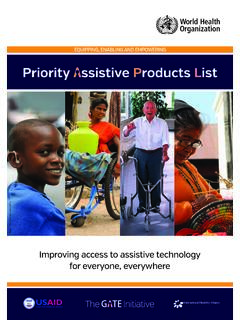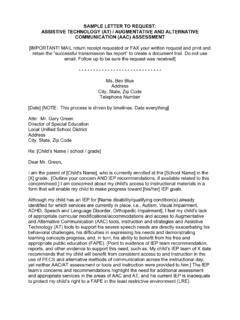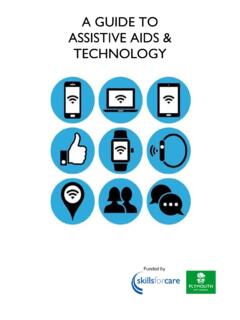Transcription of Use of Educational Technology in Special Education ...
1 Participatory Educational Research (PER) Vol. 6(2), pp. 189-205, December, 2019 Available online at ISSN: 2148-6123 Use of Educational Technology in Special Education : Perceptions of Teachers Kursat CAGILTAY Computer Education and Instructional Technology , Middle East Technical University, 06800, Ankara, Turkey. Hasan CAKIR Computer Education and Instructional Technology , Gazi University, 06500, Ankara, Turkey. Necdet KARASU Special Education , Gazi University, 06500, Ankara, Turkey. Omer Faruk ISLIM* Computer Education and Instructional Technology , K r ehir Ahi Evran University,40100 Kirsehir, Turkey.
2 Filiz CICEK Computer Education and Instructional Technology , Middle East Technical University, 06800, Ankara, Turkey Article history Received: Received in revised form: Accepted: The purpose of this study is to understand opinions, experiences, and perceptions of Special Education teachers with Educational technologies. This study is a part of a larger project that targets developing instructional materials for students with Special needs, their teachers and parents. Needs analysis was conducted to understand the current situation. Participants were 27 teachers in 6 different schools from Ankara, Turkey.
3 The data were collected using semi-structured interviews and analyzed by taking content analysis approach. The results indicated that teachers use of Technology for instructional purposes was very limited due to lack of infrastructure and appropriate material. Teachers believe that Technology use in classroom improves quality of Educational outcomes and job satisfaction. In relation to learning new technologies for Educational use, teachers do not feel obligation to learn new technologies unless it becomes a necessity. Moreover, there is a large potential to develop materials in Special Education field with new technologies.
4 Along with developing materials for students using bodily movement detection, touch screen, and smart toys technologies, it is also necessary to train teachers how to use them in classroom and to train parents to continue student s Education at home. Materials could support teachers while teaching self-care skills, social skills, and cognitive concepts. Moreover, Key words: Turkey, teaching materials, Education , Special Education *Correspondency: +90 386 280 51 29 Use of Educational Technology in Special Cagiltay, H. Cakir, N. Karasu, Islim, F. Cicek Participatory Educational Research (PER) -190- they help students to reinforce and transfer these skills and knowledge to new contexts by providing many practice-feedback and variety of real contexts.
5 Introduction With the development of computers, Technology in Education has dramatically changed and variety of opportunities emerged to support teaching and learning processes. As processing and storage capacity of computers improved, their role of supporting teaching and learning has evolved. Utilizing computers to deliver the instructional content with supportive multimedia elements such as interactive images, videos, animations, simulations, and computer games made computers as standalone supporter of students and teachers ( Hew & Cheung, 2010; Means, Toyama, Murphy, Bakia, & Jones, 2009; Ma & Nickerson, 2006; Penuel, 2006; Rutten, van Joolingen, & van der Veen, 2012).
6 Continuous developments in the information and communication technologies (ICT) had its share in the instructional technologies as well. While nowadays much of the research focuses on instructional technologies to be utilized to improve active learning and interactions among teachers and students in regular learning environments, teachers and students from Special Education group have not much benefited from these developments. Many of the technologies in the Special Education field were called as assistive technologies (Edyburn, 2013; Okolo & Bouck, 2007). The assistive Technology Act (2004), which was signed by the US Government in October 25, 2004, defines assistive Technology as Any item, piece of equipment or product system, whether acquired commercially off the shelf, modified, or customized, that is used to increase, maintain, or improve functional capabilities of individuals with disabilities.
7 The assistive Technology is an umbrella term that covers walkers, wheelchairs, hardware, software and any kind of equipment that helps and ease the life of people with disabilities. These technologies give chance disabled people to have independent life and involve in the society (World Health Organization, 2012) Current Technology holds great potential for teaching and learning activities in Special Education area. Alternative ways of interaction with computers, fast-responding processors, high definition animated graphics, and communication/collaboration over the internet facilitate better learning environments for students, teachers, and parents.
8 Game consoles such as Nintendo s Wii and Microsoft s Xbox and tablets provide different modes of interaction with computers than traditional mouse-keyboard model. In traditional model, the user gives commands to computers by using keyboard and mouse, however, using keyboard and mouse requires hand and eye coordination to be used effectively (Laursen, Jensen, Garde & Jargensen, 2002), for which not all Special Education students may have such skills (Shimizu, Yoon, and McDonough, 2010). Instead of using mouse and keyboard, using body gestures or touch screens to interact with computers provides better interaction and user experience results (Findlater, Froehlich, Fattal, Wobbrock & Dastyar, 2013; Lee, Isenberg, Riche & Carpendale, 2012; Wachs, K lsch, Stern & Edan, 2011).
9 Students with Special learning needs or students with developmental disabilities can be considered as a type of students with low academic ability students. Some of the general learner characteristics include short attention span, low capacity of working memory, need for repetitious practice and feedback sessions, and difficulties to make connections between events and characters in the same story (Bender, 2008; Taylor, Richards, & Brady, 2005; Wenar & Kerig, 2006). Typical instruction for these students is highly structured, provides strict guidelines, progresses with small steps, repeats practices and feedback sessions as many times as students need (Kirk, Gallagher, Coleman, & Anastasiow, 2011; Smith, Polloway, Patton, & Participatory Educational Research (PER), 6 (2);189-205, 1 December 2019 Participatory Educational Research (PER) -191- Dowdy, 1990).
10 This type of instruction can be developed with Educational Technology tools such as computers, tablets, or game consoles. Research shows that Special Education students benefit from Educational Technology , especially in concept teaching and in practice-feedback type instructional activities (Carter & Center, 2005; Hall, Hughes, & Filbert, 2000; Hasselbring & Glaser, 2000). Generally, video based, or keyboard-mouse interaction type computer-based technologies have been utilized in Special Education cases, which have very limited student interaction and feedback capacities. However, computer technologies that allow students to interact via alternative channels such as body gestures or touch screens have potential to produce better learning results for students (Hwang, Wu & Fan-Ray, 2013).














